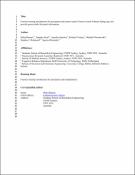Options
Friction sensing mechanisms for perception and motor control: passive touch without sliding may not provide perceivable frictional information
Alternative Title
Friction sensing mechanisms for perception and manipulation
Date Issued
2021-03-22
Date Available
2024-05-08T10:03:17Z
Abstract
Perception of the frictional properties of a surface contributes to the multidimensional experience of exploring various materials; we slide our fingers over a surface to feel it. In contrast, during object manipulation, we grip objects without such intended exploratory movements. Given that we are aware of the slipperiness of objects or tools that are held in the hand, we investigated whether the initial contact between the fingertip skin and the surface of the object is sufficient to provide this consciously perceived frictional information. Using a two-alternative forced-choice protocol, we examined human capacity to detect frictional differences using touch, when two otherwise structurally identical surfaces were brought in contact with the immobilized finger perpendicularly or under an angle (20° or 30°) to the skin surface (passive touch). An ultrasonic friction reduction device was used to generate three different frictions over each of three flat surfaces with different surface structure: 1) smooth glass, 2) textured surface with dome-shaped features, and 3) surface with sharp asperities (sandpaper). Participants (n = 12) could not reliably indicate which of the two surfaces was more slippery under any of these conditions. In contrast, when slip was induced by moving the surface laterally by a total of 5 mm (passive slip), participants could clearly perceive frictional differences. Thus making contact with the surface, even with moderate tangential forces, was not enough to perceive frictional differences, instead conscious perception required a sufficient size slip.
Sponsorship
Science Foundation Ireland
Other Sponsorship
Insight Research Centre
Australian Research Council Discovery Grant
Type of Material
Journal Article
Publisher
American Physiological Society
Journal
Journal of Neurophysiology
Volume
125
Issue
3
Start Page
809
End Page
823
Copyright (Published Version)
2021 the American Physiological Society
Language
English
Status of Item
Peer reviewed
This item is made available under a Creative Commons License
File(s)
Loading...
Name
Friction sensing mechanisms for perception and motor control- Passive touch without sliding may not provide perceivable frictional information .pdf
Size
2.73 MB
Format
Adobe PDF
Checksum (MD5)
60775f870b7810f4729ce8ab57086b20
Owning collection
Mapped collections